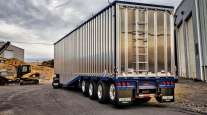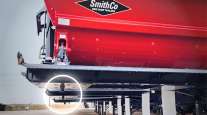Trailer Standards Draw Near

This story appears in the March 13 print edition of Equipment & Maintenance Update, a supplement to Transport Topics.
Trailers purchased by fleets in 2018 must comply with Phase 2 of the greenhouse-gas rule from the Environmental Protection Agency and the National Highway Traffic Safety Administration, but there will be a menu of equipment options for achieving compliance.
For 53-foot box vans and refrigerated trailers, fleets will choose among a combination of low-rolling-resistance tires, side skirts and other aerodynamic devices, automatic tire inflation systems, or ATIS, tire pressure monitoring systems, or TPMS, and lighter-weight components, such as aluminum wheels and wide-base tires. The same options are available for flatbed trailers, apart from aerodynamic devices, which do not bring the same advantages to flatbeds.
In recent years, the high cost of diesel fuel had encouraged many fleets to use these technologies voluntarily.
BEST OF MARCH E&MU: More stories, columns
“Many Great Dane customers already have specs that are close to being compliant because they have low-rolling-resistance tires,” said Chris Lee, vice president of engineering at trailer maker Great Dane Trailers.
“We allow fleets to choose the actual components they want to meet their compliance goals,” Lee said. “This allows each fleet operation to achieve a compliant package in a way that meets their unique needs.” Because side skirts “provide high benefit, we expect many customers to choose them,” Lee added.
Each trailer that is sold must be compliant with the regulation, and the specific requirements differ according to the type of trailer.
“The compliance levels are based on the limitations of each product family,” said Gary Fenton, vice president of engineering at Stoughton Trailers.
Flatbeds and chassis are considered nonaerodynamic, while reefers are considered partially aerodynamic.
“Reefers and some other trailers may have side doors that restrict the use of side skirts,” Fenton said. Flatbed trailers may not be subject to aerodynamic regulations, “but at the minimum they are subject to regulations for tires, ATIS and TPMS.”
In most cases, box vans will require more than one component to achieve compliance, Fenton said. “Some families of product, such as flatbed trailers, could be compliant solely through low-rolling-resistance tires, but families of product that are either partial or full aero are unlikely to achieve compliance strictly through low-rolling- resistance tires, ATIS and TPMS.”
Weight savings is another option.
“There is a menu of known weight effects, based on options that are common to trailers, such as aluminum wheels and wide-base tires,” Fenton said. “These all have a known weight effect, so there are multipliers already in the [GHG Phase 2] documentation that are used for the calculation.”
But these options come at a price.
“The GHG Phase 2 regulations will increase the cost of trailers,” Fenton said.
The side skirt, which is the most common aerodynamic system, costs $800 to $1,200 for a trailer priced at about $22,000, Fenton said.
And some carriers see the regulations as adding cost without a clear benefit.
Minnesota-based Styer Transportation, which runs about 125 trailers, already uses low-rolling-resistance tires, aerodynamic devices and ATIS, said Russ Simon, vice president of operations.
“The [Phase 2] regulations will require us to pay to have this technology on the trailers, but I don’t have any way of documenting any proof that fuel mileage is getting any better,” he said.
Simon added, “There are too many variables for me to consider. Not all of my loads are the same weight. They’re not all run by the same type of truck.
“This makes it impossible for me to determine if these devices are helping my fuel mileage or not. I know that tests done in wind tunnels show that they work, but in real life, I can’t claim to have results that confirm that.”
Les Jaworski, general manager of R&D product support at trailer manufacturer Hyundai Translead, meanwhile, emphasized that compliance with GHG Phase 2 extends beyond the initial purchase of the trailer. “The fleet owners need to be aware that all EPA devices installed by OEMs may not be disabled or removed by the owners of the fleet.”
Fenton made a similar point.
“When fleets buy a trailer sold with regulatory components in place, those components must be maintained,” he said. “If one is damaged or removed, then it must be replaced with an equivalent component. They must be maintained in operating condition.”
Many fleets already use low-rolling- resistance tires to improve fuel efficiency.
“Rolling resistance is the energy a tire consumes while rolling under load,” said Sharon Cowart, director of product marketing for Michelin Truck Tires. Michelin uses “technologically advanced compounds and tire-construction techniques to minimize a tire’s rolling resistance.”
Fuel costs represent the single highest nonpayroll operating expense for longhaul fleets, and it is estimated that a third of heavy-duty truck fuel consumption is used to overcome rolling resistance, Cowart said.
“The lower the rolling resistance, the less fuel consumed,” she said. “A 3% reduction in rolling resistance translates into a 1% fuel savings or an increase of 0.05 miles per gallon.”
At Goodyear, low rolling resistance typically is achieved through a combination of specially formulated rubber compounding and precision tread designs, said Brian Buckham, general manager of product marketing at the tire maker.
Goodyear has designed and manufactured low-rolling-resistance tires and retread products “for many years, well before present-day GHG regulations went into effect,” Buckham said. From a product development perspective, “We are more than well-positioned to meet or exceed GHG Phase 2 requirements,” he said.
Premier Trailer Leasing, a national company, has about 35,000 trailers in its fleet and about 80% of its inventory is 53-foot dry vans.
“All of our trailers have low-rolling- resistance tires,” Executive Vice President Larry Hall said. “About a third of our fleet has some sort of aerodynamic device.”
Hall said Premier expects to use ATIS as part of its effort to comply with GHG Phase 2 regulations for 2018.
“The cost of tire inflation is starting to come down,” he said. “It’s not as low as the side skirts, but it’s approaching that. And the benefit is higher for us, because it also helps extend tire life.”
Another industry executive, meanwhile, argues that the GHG Phase 2 regulations are counterproductive.
“Our view is that this should be voluntary through the SmartWay program,” said Jeff Sims, president of the Truck Trailer Manufacturers Association.
EPA’s SmartWay program helps fleets identify fuel-saving technologies.
“Those fleets that know and can get benefits will do so,” Sims said, “and those that can’t will not be forced to buy something that is of zero use to them.”
According to Sims, aerodynamic devices do more harm than good on many trailers.
“Right now, fleets that buy SmartWay-compliant trailers are doing so based on their particular operation,” he said. “If they are running at highway speeds most of the time, they get the benefit from the aerodynamic devices.”
However, GHG Phase 2 will “force manufacturers to sell all of these devices to fleets that never run at highway speeds,” Sims said.
“In these instances, all the added devices do is add weight and cost,” he added.
This is particularly true for trucks that handle city deliveries, Stoughton’s Fenton said.
These trucks “may never experience the value of drag reduction,” he said.
“As a matter of fact, when you add these components that are supposed to be beneficial in reducing greenhouse-gas emissions, you’re adding weight to the trailer, so you’re therefore adding greenhouse gas rather than diminishing it,” Fenton added.
Hall, of Premier Trailer Leasing, mentioned another downside to the aerodynamic devices — extra maintenance.
“They provide something else that can get damaged,” he said. “For short hauls, it’s hard to justify the cost, because you aren’t reaching the highway speeds that bring the fuel-efficiency advantages.”
One of the vital aspects of the GHG Phase 2 regulation is that it is a mandate for the entire industry, Hall said.
“If Premier simply chose to use some of these technologies independently,” he said, “the added cost would price us out of the market in some cases. Having the regulations apply to everyone serves to level the playing field.”
“[Premier] believes in improvements in the way we operate that make sense, that make the public safer, that lower our overall cost and that reduce pollution,” Hall said.
Regulations need to have a cost-benefit balance, he added.
“If regulations, improvements or new technologies benefit the industry by lowering overall costs, help us improve the environmental impact by reducing emissions and keep people working, that’s good,” Hall said. “Regulations that do nothing but add costs that drive companies out of business are a problem. The technologies that both improve your overall cost and reduce your carbon footprint are ideal.”
Trailer manufacturers Wabash National Corp. and Utility Trailer Manufacturing Co. declined requests for comment for this story.




